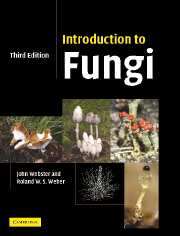Book contents
- Frontmatter
- Contents
- Preface to the first edition
- Preface to the second edition
- Preface to the third edition
- Acknowledgements
- 1 Introduction
- 2 Protozoa: Myxomycota (slime moulds)
- 3 Protozoa: Plasmodiophoromycota
- 4 Straminipila: minor fungal phyla
- 5 Straminipila: Oomycota
- 6 Chytridiomycota
- 7 Zygomycota
- 8 Ascomycota (ascomycetes)
- 9 Archiascomycetes
- 10 Hemiascomycetes
- 11 Plectomycetes
- 12 Hymenoascomycetes: Pyrenomycetes
- 13 Hymenoascomycetes: Erysiphales
- 14 Hymenoascomycetes: Pezizales (operculate discomycetes)
- 15 Hymenoascomycetes: Helotiales (inoperculate discomycetes)
- 16 Lichenized fungi (chiefly Hymenoascomycetes: Lecanorales)
- 17 Loculoascomycetes
- 18 Basidiomycota
- 19 Homobasidiomycetes
- 20 Homobasidiomycetes: gasteromycetes
- 21 Heterobasidiomycetes
- 22 Urediniomycetes: Uredinales (rust fungi)
- 23 Ustilaginomycetes: smut fungi and their allies
- 24 Basidiomycete yeasts
- 25 Anamorphic fungi (nematophagous and aquatic forms)
- References
- Index
- Plate section
17 - Loculoascomycetes
- Frontmatter
- Contents
- Preface to the first edition
- Preface to the second edition
- Preface to the third edition
- Acknowledgements
- 1 Introduction
- 2 Protozoa: Myxomycota (slime moulds)
- 3 Protozoa: Plasmodiophoromycota
- 4 Straminipila: minor fungal phyla
- 5 Straminipila: Oomycota
- 6 Chytridiomycota
- 7 Zygomycota
- 8 Ascomycota (ascomycetes)
- 9 Archiascomycetes
- 10 Hemiascomycetes
- 11 Plectomycetes
- 12 Hymenoascomycetes: Pyrenomycetes
- 13 Hymenoascomycetes: Erysiphales
- 14 Hymenoascomycetes: Pezizales (operculate discomycetes)
- 15 Hymenoascomycetes: Helotiales (inoperculate discomycetes)
- 16 Lichenized fungi (chiefly Hymenoascomycetes: Lecanorales)
- 17 Loculoascomycetes
- 18 Basidiomycota
- 19 Homobasidiomycetes
- 20 Homobasidiomycetes: gasteromycetes
- 21 Heterobasidiomycetes
- 22 Urediniomycetes: Uredinales (rust fungi)
- 23 Ustilaginomycetes: smut fungi and their allies
- 24 Basidiomycete yeasts
- 25 Anamorphic fungi (nematophagous and aquatic forms)
- References
- Index
- Plate section
Summary
Introduction
The characteristic feature of this group is that the ascus is bitunicate and fissitunicate; it has two separable walls (see p. 240). The outer wall (ectotunica or ectoascus) does not stretch readily, but ruptures laterally or at its apex to allow the stretching of the thinner inner layer, the endotunica or endoascus (Figs. 17a–c). Asci are generally non-amyloid. The fruit body with asci is regarded as an ascostroma, and each cavity in which asci develop is termed a locule. In contrast to the Hymenoascomycetes, in which ascocarps develop following plasmogamy and the pairing up of two genetically dissimilar nuclei (ascohymenial development), in the Loculoascomycetes the ascoma is already present before the compatible nuclei are brought together (Barr & Huhndorf, 2001). The development of asci in pre-formed locules is called ascolocular. The ascostroma has therefore been defined as an aggregation of vegetative hyphae not resulting from a sexual stimulus (Wehmeyer, 1926). However, Holm (1959) has questioned the accuracy of this definition, since examples are known where the ascocarps do develop following the pairing of nuclei (Shoemaker, 1955). Within the developing ascocarp, one or more locules are formed by the downgrowth of pseudoparaphyses (see below) and the development of asci. One or more ostioles then develop by the breakdown (lysis) of a pre-formed mass of tissue (lysigenous development). Where a single locule develops, a structure resembling a perithecium results and, although this term is commonly used for such loculoascomycete fruit bodies, they should strictly be called pseudothecia (see p. 245).
- Type
- Chapter
- Information
- Introduction to Fungi , pp. 459 - 486Publisher: Cambridge University PressPrint publication year: 2007
- 1
- Cited by

